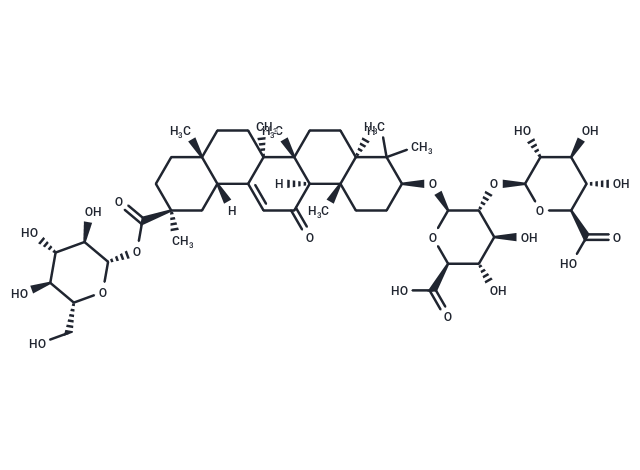Shopping Cart
- Remove All
 Your shopping cart is currently empty
Your shopping cart is currently empty

Licoricesaponin A3 is a terpenoid saponin extracted from Gymnostachyum febrifugum Benth., which has good affinity for 5-LOX receptors.

| Pack Size | Price | Availability | Quantity |
|---|---|---|---|
| 5 mg | $2,198 | Backorder | |
| 1 mL x 10 mM (in DMSO) | Inquiry | Backorder |
| Description | Licoricesaponin A3 is a terpenoid saponin extracted from Gymnostachyum febrifugum Benth., which has good affinity for 5-LOX receptors. |
| In vitro | Fourteen triterpenoid saponins were isolated from the 50% ethanol extract of the root and rhizome of Glycyrrhiza uralensis, namely glycyrrhizin C (1), glycyrrhizin D (2), glycyrrhizin A3 (3), glycyrrhizin F (4), 22β-acetoxyglycyrrhizin (5), 24-hydroxyglycyrrhizin E2 (6), glycyrrhizin E2 (7), glycyrrhizin G2 (8), 22β-acetoxyglycyrrhizin (9), 3β-O-[β-D-glucuronopyranosyl-(12)-β-D-glucuronopyranosyl]-glycyrrhizinol (10), arabinoside (11), glycyrrhizin J2 (12), glycyrrhizin (13) and glycyrrhetinic acid monoglucuronide (14). Compounds 1 to 14 have cytotoxic activity against human cancer cell lines MGC-803, SW620, and SMMC-7721, with IC50 values greater than 100 μM; the aglycones of compounds 2, 6 to 8, and 13 have inhibitory effects on cancer cell growth, with IC50 values ranging from 18.3 to 41.6 μM. [1] |
| Molecular Weight | 985.07 |
| Formula | C48H72O21 |
| Cas No. | 118325-22-7 |
| Smiles | C[C@]12[C@@]([C@]3(C)[C@@](CC1)(C(C)(C)[C@@H](O[C@H]4[C@H](O[C@@H]5O[C@H](C(O)=O)[C@@H](O)[C@H](O)[C@H]5O)[C@@H](O)[C@H](O)[C@@H](C(O)=O)O4)CC3)[H])(C(=O)C=C6[C@@]2(C)CC[C@]7(C)[C@]6(C[C@](C(O[C@@H]8O[C@H](CO)[C@@H](O)[C@H](O)[C@H]8O)=O)(C)CC7)[H])[H] |
| Relative Density. | 1.31g/cm3 |
| Storage | store at low temperature,keep away from moisture | Powder: -20°C for 3 years | In solvent: -80°C for 1 year | Shipping with blue ice. |

Copyright © 2015-2025 TargetMol Chemicals Inc. All Rights Reserved.